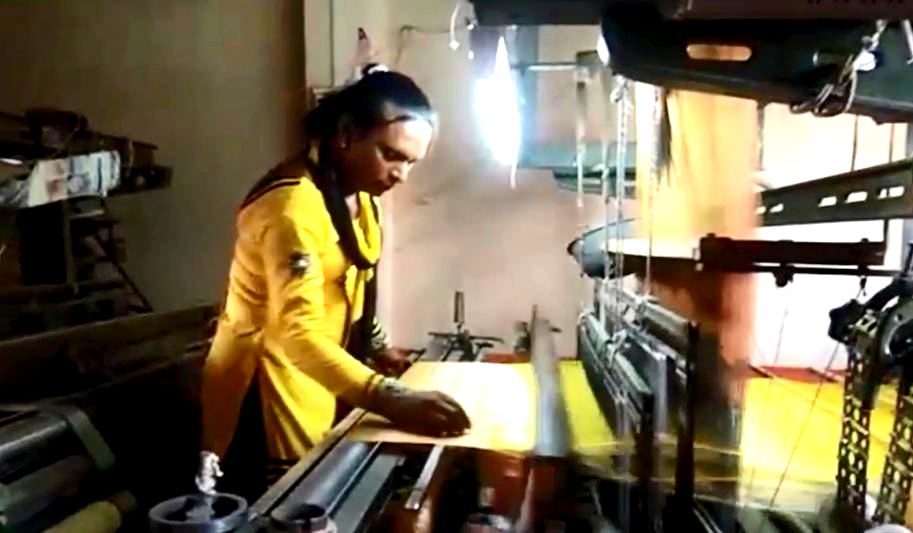How a transgender weaver in Varanasi is changing social norms by being herself
“I spent my childhood with girls, and I never thought of myself as a boy, I always thought I was a girl,” said Abdul Hakim urf Gudiya. Today she identifies as a kinnar, working as a weaver in Varanasi.
‘Kinnar’, like ‘hijra’, is one of the many colloquial terms used to refer to the third gender–people who do not identify with the gender binaries assigned at birth. Almost exclusively used by those assigned male at birth, it could a term used for those who identify as women or identify as neither men nor women.
“People in my home were the first to start talking about me, saying I was this or that,” she explained, “So Gudiya left her house when she was 17 years old to live with her guru, an authority figure whom the kinnars report to. Kinnars often organize themselves into their own societal structures; gurus, often older kinnars, help new initiates called chelas (students) navigate society as out kinnars. Gurus and chelas in turn have their own social systems, codes of conduct, rules and even languages.
Despite their respected presence in Hindu mythology and histories of a variety of Hindu and Muslim kingdoms in India, hijras today are met with societal rejection. One of the few roles assigned to them is dancing at celebrations like weddings to bless the event. For many, it becomes the singular source of income. Gurus are responsible for teaching this song-and-dance routine, as well as assigning territories for hijras to perform. Gudiya, too, used to dance. “Whatever money I earned, it was taken by my guru,” said Gudiya. Hijras’ exploitation at the hands of their gurus has been a common occurrence — from having to give them all their earnings to being pushed into sex work.
Gudiya soon had a revelation: “I realized that I was surviving today because I was healthy and able to dance, but what would I do in the future when I couldn’t dance anymore?” Despite the fact that hijras existed on the fringes of society, and were only acceptably visibilized in certain jobs–such as dancers, sex workers and beggars–she decided that she would leave her guru’s house and try to stand on her own two feet.
It was not easy. “I used to help clean houses and maintain lawns, anything to learn a little bit of money and feed myself,” she described. And finding acceptance in mainstream society has never been easy. “My Muslim community think of hijras as untouchable,” she disclosed, “They can’t feed us one roti but they can beat the daylights out of us.”
She knew the cost of her presenting as a woman, dressing in salwar-kameezes with long hair and touches of make-up. “If I take off these clothes, then I can get work from them,” she explained bluntly, “But if I continue to dress like this, I won’t get anything.”
Slowly but surely, strongly determined, Gudiya learnt how to weave – her guru had initiated her into the craft. She is today a professional weaver. But her identity as a kinnar often makes it difficult for Gudiya to get consistent get work. “If in a week I get Rs. 500, I get Rs. 500; I could get Rs. 1000 for the same job. And I could also get nothing,” she said matter-of-factly. It is perhaps the fact that she grew up hiding herself that is now defiant about changing anything about herself to fit societal norm: “For many days, I tried to hide from my true self. But it became too much,” she said defiantly, and with a hint of disbelief still lingering in her voice, “I never thought that I would be able to present myself in a feminine manner in public.”
But there are problems still. The machine in Gudiya’s workshop hasn’t been working for the last six months and electricity is erratic at best. But people continue to assume the worst of her, “They have a poor perception of me. They worry that if they give me work, I won’t give it back to them,” she revealed, but added with the frustration evident in her voice, “But this is how I earn my daily living. What I will get out of taking something from someone?” “It’s just God’s grace that I am able to still put food on the table,” she added.
Gudiya’s responsibilities extend beyond her own self. She has been in a live-in relationship with her partner, who identifies as cisgender male, for the last nine years. Together, they have adopted two daughters, aged 15 and 4.
Her partner, Khurshid Ahmed, spoke about how they’ve been going through a tough time. “There was a lot of disapproval from my family,” he said, “Everybody was against this relaitonship.” But at the end of the day, “We are a part of a family, he left his home for me,” said Gudiya, “When I die, I know he will be there to do my last rites.”
When, in the historic 2014 Supreme Court judgement recognizing the legal validity of the third gender, the Court asked the government to consider treating people identifying as the third gender in line with other minority communities, there was hope that it would result in social and economic upliftment. However, Gudiya has no faith in the government, “I filled the forms that now have a third gender option, but it all ends with the paperwork. I haven’t been able to get any bank loans to date.”
“I will only count on my own two hands and legs, nothing and nobody else. I will fight against the world to survive,” said Gudiya defiantly, and spoke of the real need and lack most powerfully, “Money, I can earn. But money is just what I earn. I also want respect.”
This Khabar Lahariya article first appeared on Firstpost.


